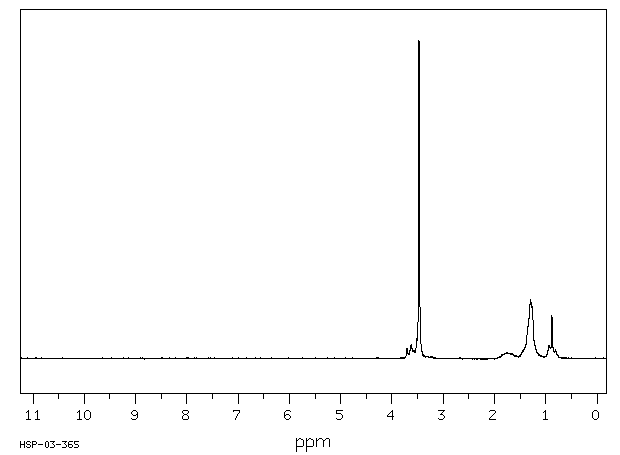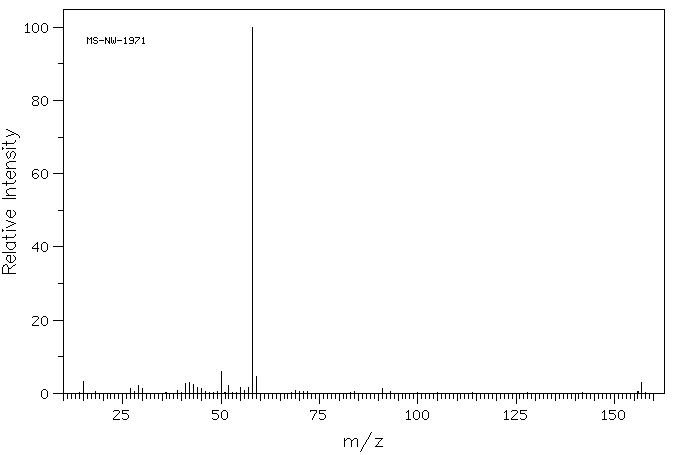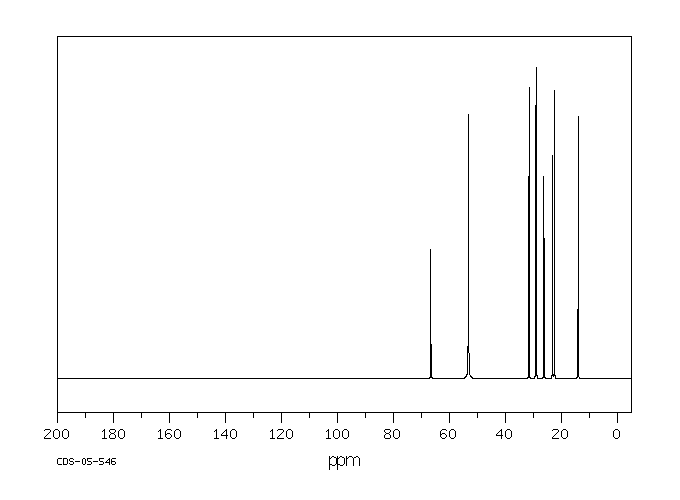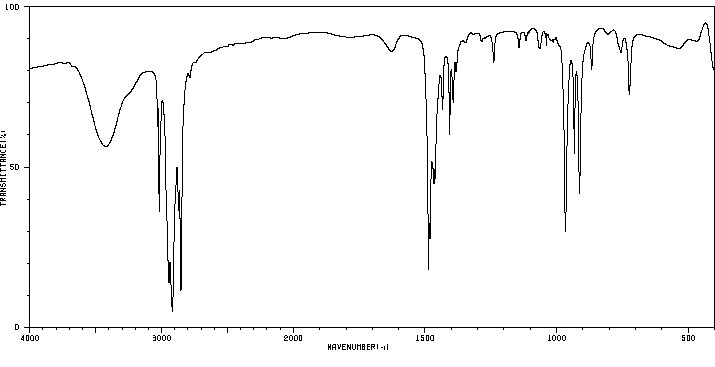辛基三甲基氯化铵 | 10108-86-8
中文名称
辛基三甲基氯化铵
中文别名
正辛基三甲基氯化铵;八烷基三甲基氯化铵
英文名称
octyltrimethylammonium chloride
英文别名
trimethyloctylammonium chloride;n-octyltrimethylammonium chloride;OTAC;trimethyl(octyl)azanium;chloride
CAS
10108-86-8
化学式
C11H26N*Cl
mdl
——
分子量
207.787
InChiKey
AQZSPJRLCJSOED-UHFFFAOYSA-M
BEILSTEIN
——
EINECS
——
-
物化性质
-
计算性质
-
ADMET
-
安全信息
-
SDS
-
制备方法与用途
-
上下游信息
-
文献信息
-
表征谱图
-
同类化合物
-
相关功能分类
-
相关结构分类
计算性质
-
辛醇/水分配系数(LogP):0.06
-
重原子数:13
-
可旋转键数:7
-
环数:0.0
-
sp3杂化的碳原子比例:1.0
-
拓扑面积:0
-
氢给体数:0
-
氢受体数:1
安全信息
-
危险品标志:Xi
-
安全说明:S26,S36,S36/37/39
-
危险类别码:R36/37/38
-
WGK Germany:3
-
海关编码:2923900090
-
危险标志:GHS07
-
危险性描述:H315,H319,H335
-
危险性防范说明:P261,P305 + P351 + P338
-
储存条件:存放于惰性气体中,并避免接触湿气(吸湿)。
SDS
Section 1. IDENTIFICATION OF THE SUBSTANCE/MIXTURE
Product identifiers
Product name : Trimethyloctylammonium chloride
CAS-No. : 10108-86-8
Relevant identified uses of the substance or mixture and uses advised against
Identified uses : Laboratory chemicals, Manufacture of substances
Section 2. HAZARDS IDENTIFICATION
Classification of the substance or mixture
Classification according to Regulation (EC) No 1272/2008 [EU-GHS/CLP]
Skin irritation (Category 2)
Eye irritation (Category 2)
Specific target organ toxicity - single exposure (Category 3)
Classification according to EU Directives 67/548/EEC or 1999/45/EC
Irritating to eyes, respiratory system and skin.
Label elements
Labelling according Regulation (EC) No 1272/2008 [CLP]
Pictogram
Signal word Warning
Hazard statement(s)
H315 Causes skin irritation.
H319 Causes serious eye irritation.
H335 May cause respiratory irritation.
Precautionary statement(s)
P261 Avoid breathing dust/ fume/ gas/ mist/ vapours/ spray.
P305 + P351 + P338 IF IN EYES: Rinse cautiously with water for several minutes. Remove
contact lenses, if present and easy to do. Continue rinsing.
Supplemental Hazard none
Statements
According to European Directive 67/548/EEC as amended.
Hazard symbol(s)
R-phrase(s)
R36/37/38 Irritating to eyes, respiratory system and skin.
S-phrase(s)
S26 In case of contact with eyes, rinse immediately with plenty of water and
seek medical advice.
S36 Wear suitable protective clothing.
Caution - substance not yet tested completely.
Other hazards - none
Section 3. COMPOSITION/INFORMATION ON INGREDIENTS
Substances
Synonyms : Octyltrimethylammonium chloride
Formula : C11H26ClN
Molecular Weight : 207,78 g/mol
Component Concentration
N,N,N-Trimethyl-1-octanamonium chloride
CAS-No. 10108-86-8 -
Section 4. FIRST AID MEASURES
Description of first aid measures
General advice
Consult a physician. Show this safety data sheet to the doctor in attendance.
If inhaled
If breathed in, move person into fresh air. If not breathing, give artificial respiration. Consult a physician.
In case of skin contact
Wash off with soap and plenty of water. Consult a physician.
In case of eye contact
Rinse thoroughly with plenty of water for at least 15 minutes and consult a physician.
If swallowed
Never give anything by mouth to an unconscious person. Rinse mouth with water. Consult a physician.
Most important symptoms and effects, both acute and delayed
To the best of our knowledge, the chemical, physical, and toxicological properties have not been
thoroughly investigated.
Indication of any immediate medical attention and special treatment needed
no data available
Section 5. FIREFIGHTING MEASURES
Extinguishing media
Suitable extinguishing media
Use water spray, alcohol-resistant foam, dry chemical or carbon dioxide.
Special hazards arising from the substance or mixture
Carbon oxides, nitrogen oxides (NOx), Hydrogen chloride gas
Advice for firefighters
Wear self contained breathing apparatus for fire fighting if necessary.
Further information
no data available
Section 6. ACCIDENTAL RELEASE MEASURES
Personal precautions, protective equipment and emergency procedures
Use personal protective equipment. Avoid dust formation. Avoid breathing vapors, mist or gas. Ensure
adequate ventilation. Evacuate personnel to safe areas. Avoid breathing dust.
Environmental precautions
Do not let product enter drains.
Methods and materials for containment and cleaning up
Pick up and arrange disposal without creating dust. Sweep up and shovel. Keep in suitable, closed
containers for disposal.
Reference to other sections
For disposal see section 13.
Section 7. HANDLING AND STORAGE
Precautions for safe handling
Avoid contact with skin and eyes. Avoid formation of dust and aerosols.
Provide appropriate exhaust ventilation at places where dust is formed.Normal measures for preventive fire
protection.
Conditions for safe storage, including any incompatibilities
Store in cool place. Keep container tightly closed in a dry and well-ventilated place.
hygroscopic Store under inert gas.
Specific end uses
no data available
Section 8. EXPOSURE CONTROLS/PERSONAL PROTECTION
Control parameters
Components with workplace control parameters
Exposure controls
Appropriate engineering controls
Handle in accordance with good industrial hygiene and safety practice. Wash hands before breaks and
at the end of workday.
Personal protective equipment
Eye/face protection
Safety glasses with side-shields conforming to EN166 Use equipment for eye protection tested
and approved under appropriate government standards such as NIOSH (US) or EN 166(EU).
Skin protection
Handle with gloves. Gloves must be inspected prior to use. Use proper glove removal technique
(without touching glove's outer surface) to avoid skin contact with this product. Dispose of
contaminated gloves after use in accordance with applicable laws and good laboratory practices.
Wash and dry hands.
The selected protective gloves have to satisfy the specifications of EU Directive 89/686/EEC and
the standard EN 374 derived from it.
Immersion protection
Material: Nitrile rubber
Minimum layer thickness: 0,11 mm
Break through time: > 480 min
Material tested:Dermatril® ( Z677272, Size M)
Splash protection
Material: Nitrile rubber
Minimum layer thickness: 0,11 mm
Break through time: > 30 min
Material tested:Dermatril® ( Z677272, Size M)
data source: KCL GmbH, D-36124 Eichenzell, phone +49 (0)6659 873000 test method: EN374
If used in solution, or mixed with other substances, and under conditions which differ from EN 374,
contact the supplier of the CE approved gloves. This recommendation is advisory only and must
be evaluated by an Industrial Hygienist familiar with the specific situation of anticipated use by our
customers. It should not be construed as offering an approval for any specific use scenario.
Body Protection
impervious clothing, The type of protective equipment must be selected according to the
concentration and amount of the dangerous substance at the specific workplace.
Respiratory protection
For nuisance exposures use type P95 (US) or type P1 (EU EN 143) particle respirator.For higher
level protection use type OV/AG/P99 (US) or type ABEK-P2 (EU EN 143) respirator cartridges.
Use respirators and components tested and approved under appropriate government standards
such as NIOSH (US) or CEN (EU).
Section 9. PHYSICAL AND CHEMICAL PROPERTIES
Information on basic physical and chemical properties
a) Appearance Form: crystalline
Colour: white
b) Odour no data available
c) Odour Threshold no data available
d) pH no data available
e) Melting point/freezing no data available
point
f) Initial boiling point and no data available
boiling range
g) Flash point no data available
h) Evaporation rate no data available
i) Flammability (solid, gas) no data available
j) Upper/lower no data available
flammability or
explosive limits
k) Vapour pressure no data available
l) Vapour density no data available
m) Relative density no data available
n) Water solubility no data available
o) Partition coefficient: n- no data available
octanol/water
p) Autoignition no data available
temperature
q) Decomposition no data available
temperature
r) Viscosity no data available
s) Explosive properties no data available
t) Oxidizing properties no data available
Other safety information
no data available
Section 10. STABILITY AND REACTIVITY
Reactivity
no data available
Chemical stability
no data available
Possibility of hazardous reactions
no data available
Conditions to avoid
no data available
Incompatible materials
Strong oxidizing agents
Hazardous decomposition products
Other decomposition products - no data available
Section 11. TOXICOLOGICAL INFORMATION
Information on toxicological effects
Acute toxicity
no data available
Skin corrosion/irritation
no data available
Serious eye damage/eye irritation
no data available
Respiratory or skin sensitization
no data available
Germ cell mutagenicity
no data available
Carcinogenicity
IARC: No component of this product present at levels greater than or equal to 0.1% is identified as
probable, possible or confirmed human carcinogen by IARC.
Reproductive toxicity
no data available
Specific target organ toxicity - single exposure
Inhalation - May cause respiratory irritation.
Specific target organ toxicity - repeated exposure
no data available
Aspiration hazard
no data available
Potential health effects
Inhalation May be harmful if inhaled. Causes respiratory tract irritation.
Ingestion May be harmful if swallowed.
Skin
May be harmful if absorbed through skin. Causes skin irritation.
Eyes Causes serious eye irritation.
Signs and Symptoms of Exposure
To the best of our knowledge, the chemical, physical, and toxicological properties have not been
thoroughly investigated.
Additional Information
RTECS: Not available
Section 12. ECOLOGICAL INFORMATION
Toxicity
no data available
Persistence and degradability
no data available
Bioaccumulative potential
no data available
Mobility in soil
no data available
Results of PBT and vPvB assessment
no data available
Other adverse effects
no data available
Section 13. DISPOSAL CONSIDERATIONS
Waste treatment methods
Product
Offer surplus and non-recyclable solutions to a licensed disposal company. Contact a licensed
professional waste disposal service to dispose of this material. Dissolve or mix the material with a
combustible solvent and burn in a chemical incinerator equipped with an afterburner and scrubber.
Contaminated packaging
Dispose of as unused product.
Section 14. TRANSPORT INFORMATION
UN number
ADR/RID: - IMDG: - IATA: -
UN proper shipping name
ADR/RID: Not dangerous goods
IMDG: Not dangerous goods
IATA: Not dangerous goods
Transport hazard class(es)
ADR/RID: - IMDG: - IATA: -
Packaging group
ADR/RID: - IMDG: - IATA: -
Environmental hazards
ADR/RID: no IMDG Marine pollutant: no IATA: no
Special precautions for user
no data available
Section 15. REGULATORY INFORMATION
This safety datasheet complies with the requirements of Regulation (EC) No. 1907/2006.
Safety, health and environmental regulations/legislation specific for the substance or mixture
no data available
Chemical Safety Assessment
no data available
Section 16. OTHER INFORMATION
Further information
Copyright 2012 Co. LLC. License granted to make unlimited paper copies for internal use
only.
The above information is believed to be correct but does not purport to be all inclusive and shall be
used only as a guide. The information in this document is based on the present state of our knowledge
and is applicable to the product with regard to appropriate safety precautions. It does not represent any
guarantee of the properties of the product. Corporation and its Affiliates shall not be held
liable for any damage resulting from handling or from contact with the above product. See
and/or the reverse side of invoice or packing slip for additional terms and conditions of sale.
反应信息
-
作为反应物:参考文献:名称:二卤代酸盐(I):过氧化氢的合成及其卤化活性摘要:在等摩尔量的卤化氢存在下,通过用过氧化氢氧化碘和四烷基氯化铵或吡啶,可以有效地制得四烷基铵盐和吡啶鎓二氯和二溴碘酸盐(I)。在1,3-二甲氧基苯和苯乙烯作为模型底物上测试了它们的卤化活性。结果表明,ICl的2 -盐充当碘化试剂,而IBR 2 -的盐溴化两个基板。DOI:10.1016/j.tetlet.2012.08.036
-
作为产物:参考文献:名称:Scalable Synthesis of Salt-free Quaternary Ammonium Carboxylate Catanionic Surfactants摘要:DOI:10.17344/acsi.2019.5413
-
作为试剂:描述:参考文献:名称:Bram; Bensaid; Combet-Farnoux, Pharmazie, 1986, vol. 41, # 6, p. 431 - 432摘要:DOI:
文献信息
-
FLUOROALKYLATING AGENT申请人:IHARA CHEMICAL INDUSTRY CO., LTD.公开号:US20170197920A1公开(公告)日:2017-07-13Problem to be Solved It is intended to provide an industrially preferable fluoroalkylating agent and use thereof. Solution The present invention provides a fluoroalkylating agent represented by the general formula (1) wherein R 1 is a C1 to C8 fluoroalkyl group; R 2 and R 3 are each independently a C1 to C12 alkyl group or the like; Y 1 to Y 4 are each independently a hydrogen atom, a halogen atom, or the like; and X − is a monovalent anion. A compound of the general formula (3): R 4 —S—R 1 having an introduced C1 to C8 fluoroalkyl group is easily obtained by reacting a compound of the general formula (2): R 4 —S—Z wherein R 4 is a hydrocarbon group or the like; and Z is a leaving group, with the compound of the general formula (1).要解决的问题 旨在提供一种工业上可取的氟烷基化剂及其使用方法。 解决方案 本发明提供了一种由通式(1)表示的氟烷基化剂,其中R 1 是C1到C8的氟烷基团;R 2 和R 3 分别独立地是C1到C12的烷基团或类似物;Y 1 到Y 4 分别独立地是氢原子、卤素原子或类似物;X − 是一价阴离子。 通式(3)的化合物:R 4 —S—R 1 ,其中引入了C1到C8的氟烷基团,可通过将通式(2)的化合物:R 4 —S—Z(其中R 4 是烃基团或类似物;Z是离去基团)与通式(1)的化合物反应而轻松获得。
-
Enhanced color deposition for hair with sequestering agents申请人:Unilever Home & Personal Care USA, Division of Conopco, Inc.公开号:US20030135935A1公开(公告)日:2003-07-24Hair coloring compositions which comprise: (A) non-nitrogenous chelating agents from the group consisting of polyphosphate; phosphonates; hydroxycarboxylates; polyacrylates; zeolite; and mixtures thereof; (B) an oxidative dye primary intermediate; and (C) an oxidative dye coupler; (D) and water are described. The present invention also relates to a method for coloring hair which comprises contacting said hair with a hair coloring composition as described above.
-
[EN] A PERSONAL CARE COMPOSITION COMPRISING CURCUMINOIDS<br/>[FR] COMPOSITION DE SOINS PERSONNELS COMPRENANT DES CURCUMINOÏDES申请人:UNILEVER NV公开号:WO2018077958A1公开(公告)日:2018-05-03The invention relates to a personal care composition comprising a compound of the curcuminoid class and to a process of preparing it. It has been shown to have anti-inflammatory benefit and can be utilised in a wide range of personal care products, while not having the strong yellow colouration that is characteristic of many compounds of this class.这项发明涉及一种个人护理组合物,包括姜黄素类化合物,以及制备该组合物的过程。已经证明它具有抗炎益处,可用于广泛的个人护理产品中,而不具有许多该类化合物特有的强烈黄色着色。
-
Method for producing haloalkanes from alcohols申请人:Stegmann Viet公开号:US20070055084A1公开(公告)日:2007-03-08The invention relates to a process for preparing haloalkanes by reaction of alcohol with hydrogen halide, wherein the reaction of the alcohol with the hydrogen halide occurs in the presence of an ionic liquid at a temperature which is above 100° C. for at least part of the time and, at least at the time of the commencement of the reaction, the water content is not more than 25 mol % based on the amount of liquid, where the ionic liquid is not octyltrimethylammonium chloride.
-
Ion-Pairing Assemblies Based on Pentacyano-Substituted Cyclopentadienide as a π-Electronic Anion作者:Yuya Bando、Yohei Haketa、Tsuneaki Sakurai、Wakana Matsuda、Shu Seki、Hikaru Takaya、Hiromitsu MaedaDOI:10.1002/chem.201600686日期:2016.6.1Pentacyanocyclopentadienide (PCCp−), a stable π‐electronic anion, provided various ion‐pairing assemblies in combination with various cations. PCCp−‐based assemblies exist as single crystals and mesophases owing to interionic interactions with π‐electronic and aliphatic cations with a variety of geometries, substituents, and electronic structures. Single‐crystal X‐ray analysis revealed that PCCp− formedPentacyanocyclopentadienide(PCCP - ),稳定的π电子阴离子,与各种阳离子的组合所提供的各种离子配对组件。PCCP -基于组件如由于与具有多种几何形状,取代基,和电子结构的π电子和脂族阳离子离子间相互作用单晶和中间相存在。单晶X-射线分析表明PCCP -分别与从电荷通过电荷和贡献形成阳离子依赖安排电荷分离组件与π电子和脂族阳离子进行离子对模式。此外,一些脂肪族阳离子具有PCCp-来进行尺寸控制的有组织结构-,如在中间相中所观察到的,同步加速器XRD分析表明形成了电荷分离模式。为(C电导率的非接触式评价12 ħ 25)3周的MeN + ⋅ PCCP -膜电位显示空穴传输性,产生0.4厘米的地方规模空穴迁移率2 V -1 小号-1在半导体-绝缘体界面。
表征谱图
-
氢谱1HNMR
-
质谱MS
-
碳谱13CNMR
-
红外IR
-
拉曼Raman
-
峰位数据
-
峰位匹配
-
表征信息
同类化合物
(乙腈)二氯镍(II)
(R)-(-)-α-甲基组胺二氢溴化物
(N-(2-甲基丙-2-烯-1-基)乙烷-1,2-二胺)
(4-(苄氧基)-2-(哌啶-1-基)吡啶咪丁-5-基)硼酸
(11-巯基十一烷基)-,,-三甲基溴化铵
鼠立死
鹿花菌素
鲸蜡醇硫酸酯DEA盐
鲸蜡硬脂基二甲基氯化铵
鲸蜡基胺氢氟酸盐
鲸蜡基二甲胺盐酸盐
高苯丙氨醇
高箱鲀毒素
高氯酸5-(二甲氨基)-1-({(E)-[4-(二甲氨基)苯基]甲亚基}氨基)-2-甲基吡啶正离子
高氯酸2-氯-1-({(E)-[4-(二甲氨基)苯基]甲亚基}氨基)-6-甲基吡啶正离子
高氯酸2-(丙烯酰基氧基)-N,N,N-三甲基乙铵
马诺地尔
马来酸氢十八烷酯
马来酸噻吗洛尔EP杂质C
马来酸噻吗洛尔
马来酸倍他司汀
顺式环己烷-1,3-二胺盐酸盐
顺式氯化锆二乙腈
顺式吡咯烷-3,4-二醇盐酸盐
顺式双(3-甲氧基丙腈)二氯铂(II)
顺式3,4-二氟吡咯烷盐酸盐
顺式1-甲基环丙烷1,2-二腈
顺式-二氯-反式-二乙酸-氨-环己胺合铂
顺式-二抗坏血酸(外消旋-1,2-二氨基环己烷)铂(II)水合物
顺式-N,2-二甲基环己胺
顺式-4-甲氧基-环己胺盐酸盐
顺式-4-环己烯-1.2-二胺
顺式-4-氨基-2,2,2-三氟乙酸环己酯
顺式-3-氨基环丁烷甲腈盐酸盐
顺式-2-羟基甲基-1-甲基-1-环己胺
顺式-2-甲基环己胺
顺式-2-(苯基氨基)环己醇
顺式-2-(苯基氨基)环己醇
顺式-2-(氨基甲基)-1-苯基环丙烷羧酸盐酸盐
顺式-1,3-二氨基环戊烷
顺式-1,2-环戊烷二胺二盐酸盐
顺式-1,2-环戊烷二胺
顺式-1,2-环丁腈
顺式-1,2-双氨甲基环己烷
顺式--N,N'-二甲基-1,2-环己二胺
顺式-(R,S)-1,2-二氨基环己烷铂硫酸盐
顺式-(2-氨基-环戊基)-甲醇
顺-2-戊烯腈
顺-1,3-环己烷二胺
顺-1,3-双(氨甲基)环己烷










